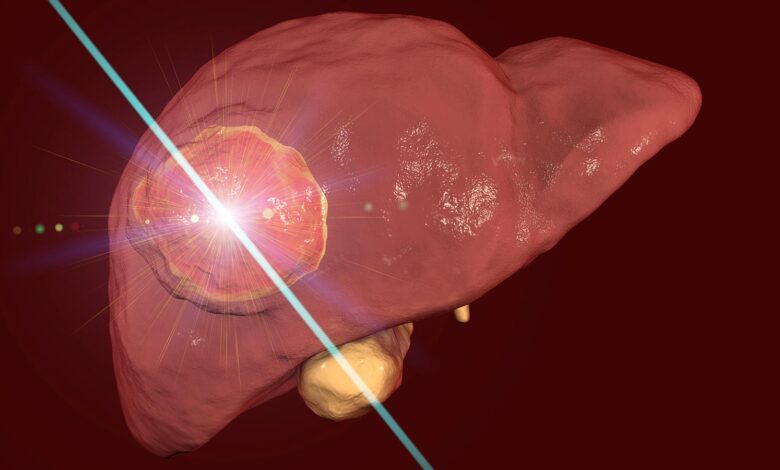Favorable Outcomes With Microwave Ablation for Colorectal Liver Metastases

—
Survival similar to resection with less morbidity, but editorial suggests use in select patients
by
Charles Bankhead, Senior Editor, MedPage Today
August 22, 2024
Microwave ablation (MWA) of colorectal liver metastases (CRLM) had low rates of failure and morbidity and warrants consideration as definitive treatment, authors of a large clinical review suggested.
Over a 16-year period, MWA had a 6.3% recurrence rate for 842 tumors and a 3.6% incidence of major complications. Four patients died within 30 days, and 1-year estimated survival was 91%. Five-year mortality was comparable to reported rates for surgical resection.
“Our data for surgical MWA compare favorably to published data on resection for CRLM,” stated David A. Iannitti, MD, of Atrium Health Carolinas Medical Center in Charlotte, North Carolina, and co-authors in the Journal of the American College of Surgeons. “Median 5-year survival after resection has been reported at 36% to 39%, which is comparable to our 5-year survival after MWA (36%). However, major complications after hepatectomy have been reported in 10% to 20% of patients. Our data show Clavien-Dindo grade IIIa to IVb complication in 12 patients, a rate of 3%.”
“Our study contributes valuable insights into the application of surgical MWA for CRLM,” they added. “Our extensive analysis of 394 surgical MWA for CRLM during a 16-year period establishes this technique as a safe, effective treatment option with outcomes comparable to resection with lower major morbidity and mortality.”
Most patients in the series had features associated with a low risk of recurrence, suggesting Iannitti and colleagues consider MWA the preferred local therapy for such patients, noted the authors of an accompanying commentary. However, the long-term outcomes with MWA are not as good as those reported for resection of low- and high-risk patients.
Reported recurrence rates with resection are 7% for multiple CRLM and 5% for a solitary CRLM, stated Antony Haddad, MD, of the University of Texas MD Anderson Cancer Center in Houston, and colleagues. Recurrence rates after R0 and R1 resection are not significantly different. The 5-year survival was 57% for patients with multiple CRLM and 71% for those with solitary liver metastasis.
Ablation was associated with higher complication rates in certain patients. Rates of operative complications, postoperative hepatic insufficiency, and 90-day mortality were all higher in patients who had one-stage hepatectomy with ablation as compared with patients who underwent two-stage hepatectomy, they added.
“Optimizing the oncological benefit of ablation in the management of CRLM requires discerning how and when to use this valuable clinical tool,” wrote Haddad and co-authors.
They cited use of CT guidance rather than ultrasound for better definition of tumor boundaries and ablation zone, further enhanced by ablation-confirmation software. The combination of resection and ablation achieves the best results when performed as a sequential strategy with resection followed by completion ablation with CT guidance.
“Although technical success is essential, the value of ablation is maximized when it is used to offer a curative-intent option to selected patients with CRLM during their longitudinal cancer care,” Haddad and co-authors concluded. “In this era of personalized local therapy, we advocate for informed decision-making related to resection and ablation, and we support the use of novel tools that will maximize the short-term and long-term outcomes of ablation.”
Although surgery has been the mainstay of treatment for CRLM, more than 75% of patients are not surgical candidates, Iannitti and colleagues noted in their introduction. Thermal ablation offers a parenchymal-sparing, minimally invasive option, with outcomes superior to those of chemotherapy alone.
Historically, radiofrequency ablation (RFA) has been used to treat primary and metastatic liver tumors, they continued. MWA offers advantages over RFA, including higher temperature to target tissue, faster ablation, larger areas of necrosis, and resistance to electrical or thermal heat sinks in the conductive zone.
Iannitti and co-authors reported findings from a retrospective analysis of 394 MWA procedures in 328 patients with CRLM from 2006 to 2022 at a single institution. The primary outcome was 1-year overall survival (OS). Secondary outcomes included postoperative complication, incomplete ablation, and recurrence (local, regional, and metastatic).
Most of the procedures involved minimally invasive techniques, including laparoscopic (77.9%) and robotic (4.8%). In 63% of MWAs, additional procedures were performed, most often hepatectomy (22.3%) and cholecystectomy (17.5%). Colectomy was performed concomitantly in 6.6% of operations.
The most common postoperative complications were nausea/vomiting (7.6%) and ileus (4.8%). Mean hospital stay was 2 days, and MWA without additional procedures was performed as an outpatient procedure in most cases. Readmission within 30 days was required for 5.3% of patients.
The 30-day mortality was 1.0%, including one patient who had a concomitant procedure. Causes of death consisted of two cases of cardiac arrest, one death after development of pneumonia and atrial fibrillation, and one death at home of unknown cause. Median follow-up for all patients was 25.8 months (range 0 to 169 months).
An analysis of recurrence per tumor showed an incomplete ablation rate of 1.5% and a local recurrence rate of 6.3%. Incomplete ablation and local recurrence were more common with tumors that were ≥3 cm. Univariate analysis showed that larger tumor size and size-related variables were associated with higher rates of incomplete ablation and local recurrence. Incomplete ablation and local recurrence were more common in Black patients.
The median disease-free survival (DFS) was 13.2 months, and median DFS at 1, 3, and 5 years was 54%, 25.3%, and 17.5%. Median OS was 38.7 months, and OS at 1, 3, and 5 years was 91.1%, 54.6%, and 30.6%.
-
![author['full_name']](https://clf1.medpagetoday.com/media/images/author/charlesBankhead_188.jpg)
Charles Bankhead is senior editor for oncology and also covers urology, dermatology, and ophthalmology. He joined MedPage Today in 2007. Follow
Disclosures
Iannitti disclosed relationships with Medtronic, AngioDynamics, and Johnson & Johnson. Two co-authors reported relationships with industry.
Haddad and co-authors reported no relevant relationships with industry.
Primary Source
Journal of the American College of Surgeons
Source Reference: Wells AB, et al “Outcomes after surgical microwave ablation for the treatment of colorectal liver metastasis” J Am Coll Surg 2024; DOI: 10.1097/XCS.0000000000001097.
Secondary Source
Journal of the American College of Surgeons
Source Reference: Haddad A, et al “Should patients with colorectal liver metastases undergo ablation?” J Am Coll Surg 2024; DOI: 10.1097/XCS.0000000000001108.



